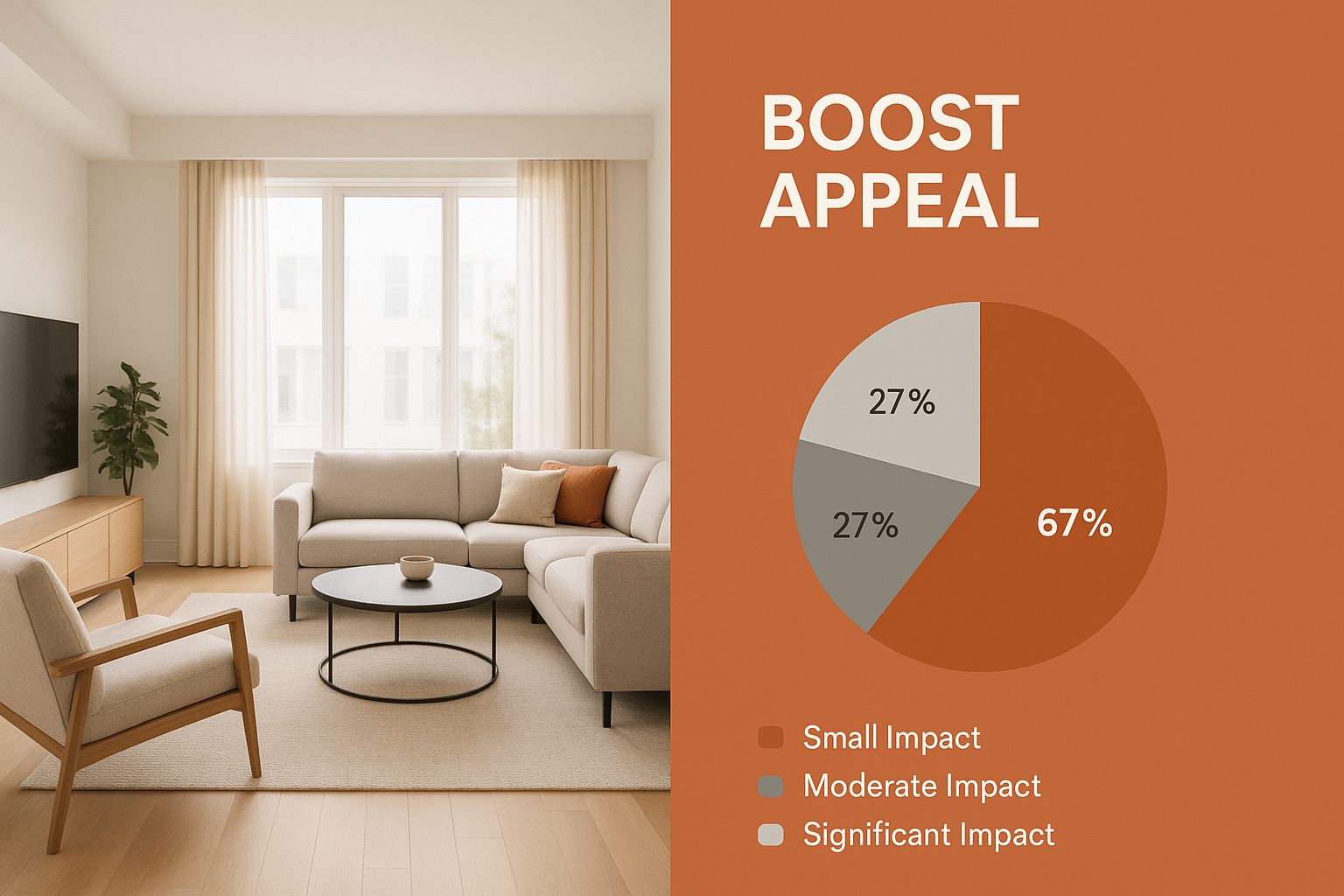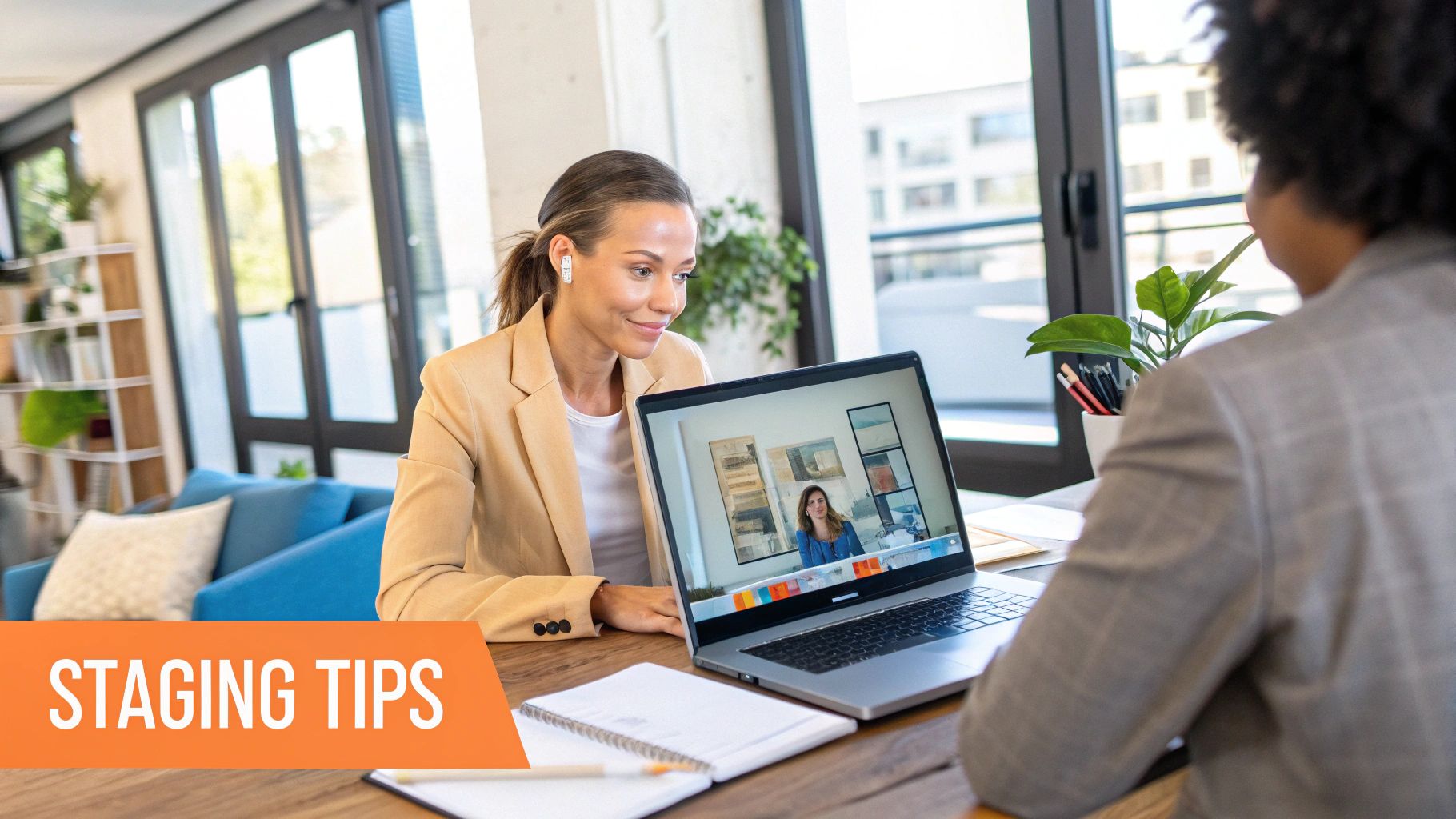Real Estate Virtual Staging: Transform Empty Spaces Quickly
Discover how real estate virtual staging can help sell properties faster. Enhance listings and attract buyers with stunning digital staging solutions.
Real estate virtual staging is changing how properties are presented and sold. This technology has evolved from basic photo editing to sophisticated 3D renderings that rival traditional staging, allowing real estate professionals to transform empty spaces into inviting homes.
Understanding the Power of Virtual Staging
Real estate virtual staging uses digital tools to add furniture, decor, and other design elements to photos of empty rooms. This helps buyers visualize a property's potential and connect with the space emotionally. It's a powerful way to showcase a property's best features and overcome challenges like awkward layouts or outdated features. You might be interested in: How to master the difference between traditional and virtual home staging .
The Evolving Landscape of Virtual Staging
Advancements in AIand3D rendering technologies like Blender have made virtual staging more accessible and realistic. Features like real-time lighting and furniture swaps empower agents to customize presentations for individual buyer preferences. Virtual staging is also becoming increasingly integrated with online listing platforms, shaping buyer expectations and influencing their search experiences.
Furthermore, home staging creates undeniable market advantage , and virtual staging offers a cost-effective way to achieve this. This allows for quick adjustments to meet changing market trends and buyer demands, meaning real estate professionals can quickly adapt their marketing to stay competitive.
The Future of Virtual Staging
Looking ahead from 2025, the virtual staging sector is projected to grow at a 12.4% CAGR through 2033, fueled by advancements in AI-enhanced renderings and interactive features. An increasing number of buyers now expect digitally staged images as part of their online search experience. Notably, virtual staging is about 97% cheaper than traditional methods and can be completed in under 72 hours, making it a practical solution for real estate professionals worldwide. Find more detailed statistics here . This cost-effectiveness and speed make virtual staging a compelling option for agents looking to maximize their marketing budgets and minimize time on the market.
Breaking Down the ROI: Virtual vs. Traditional Staging

This infographic showcases a digitally staged living room. It highlights how virtual staging can make a property more attractive to potential buyers. The image presents a warm, inviting space, demonstrating how virtual staging transforms empty rooms into appealing living areas. Virtual staging often emphasizes natural light to enhance the feeling of spaciousness, much like the benefits of good skylight ventilation . Now, let's compare the financial aspects of virtual and traditional staging.
Cost Analysis: Furnishing Pixels vs. Physical Spaces
One of the biggest differences between virtual and traditional staging is the upfront cost. Traditional staging involves renting, moving, and arranging physical furniture, which can get pricey, often costing between $766 to $2,852 per property. Virtual staging presents a significantly cheaper alternative, with prices starting as low as $50 per image. This substantial price difference makes virtual staging a compelling option, particularly for agents managing numerous properties or working with limited budgets.
Time-on-Market: Speeding Up the Sales Cycle
Virtual staging saves not just money but also valuable time. Traditional staging can take several weeks to organize and execute. Virtual staging, on the other hand, can be done in just a few days. This quicker turnaround leads to a faster sales process. Properties spend less time on the market, leading to quicker returns. Listings using virtual staging sell 75% faster than those without staging. For a deeper dive, check out this article on how to master calculating ROI for virtual staging .
Return on Investment: Maximizing Your Profits
Ultimately, the goal of any staging technique is to maximize return on investment (ROI). Virtual staging boasts an impressive ROI, typically between 500% to 3,650%. This substantially outperforms the 102% to 909% ROI usually observed with traditional staging. Furthermore, 83% of virtually staged properties sell at or above the asking price. Virtual staging has become a major trend in 2025, making it an invaluable tool for real estate professionals. For more insights, explore these key real estate statistics and trends .
Targeting Demographics: Flexibility and Customization
Beyond cost savings and quicker sales, virtual staging provides significant flexibility. Unlike the physical limitations of traditional staging, virtual staging allows agents to easily tailor a property's presentation to different buyer groups. This adaptability lets agents customize the style and ambiance of a property to connect with specific target audiences. This focused approach increases the chances of attracting the right buyers and closing successful deals.
The following table summarizes the key differences between traditional and virtual staging:
Traditional vs. Virtual Staging Comparison: A comprehensive comparison of traditional physical staging versus virtual staging across various factors including cost, timeline, flexibility, and return on investment.
| Factor | Traditional Staging | Virtual Staging | Winner |
|---|---|---|---|
| Cost | $766 - $2,852 per property | $50+ per image | Virtual Staging |
| Timeline | Weeks | Days | Virtual Staging |
| Flexibility | Limited | High | Virtual Staging |
| ROI | 102% - 909% | 500% - 3,650% | Virtual Staging |
| Time-to-Sell | Slower | 75% Faster | Virtual Staging |
| Sale Price (vs. Asking) | Varies | 83% sell at or above asking | Virtual Staging |
As the table clearly shows, virtual staging offers several advantages over traditional staging. Its lower cost, faster turnaround times, greater flexibility, and higher potential ROI make it a powerful tool for real estate professionals looking to maximize their profits and streamline their sales processes.
Transforming Metrics That Matter to Sellers

Beyond its visual appeal, real estate virtual staging makes a real difference in key sales metrics. This means sellers can potentially see better results than leaving properties empty, or even using traditional staging. Let's explore how virtual staging affects these important numbers.
Time-on-Market: Faster Sales With Virtual Staging
Virtual staging can significantly shorten a property's time on the market. Buyers visualize the space more easily, leading to faster decisions. This quicker sales cycle benefits both sellers and agents. It allows for more efficient use of time and resources.
Imagine two identical properties: one vacant, one virtually staged. The staged property is far more likely to catch a buyer's eye and sell faster.
Selling Price: Increasing Perceived Value
Studies show a link between virtual staging and higher selling prices. Presenting a furnished and styled space increases the perceived value. This can result in higher offers, maximizing the seller's return on investment.
This isn't just about pretty pictures. It's about showcasing a lifestyle. Empty rooms just can't do that.
Buyer Engagement: Sparking Interest and Emotional Connection
Virtual staging boosts buyer engagement by creating an emotional connection. Staged rooms feel welcoming and lived-in. Potential buyers can easily imagine themselves at home. This emotional connection often drives purchasing decisions.
Virtually staged properties also tend to stand out in online listings. They draw more clicks and inquiries.
Strategic Staging: Focusing on High-Impact Rooms
Not every room needs virtual staging. Research shows that staging the living room (37%), primary bedroom (34%), and kitchen (23%) makes the biggest difference to buyers. Focusing on these key areas gives the greatest return on investment. Sellers can prioritize their virtual staging efforts for maximum impact.
The following table summarizes the impact of virtual staging on different room types:
Impact of Virtual Staging by Room Type
- Statistical breakdown of how virtual staging different rooms affects buyer perception and property selling metrics
| Room Type | Buyer Impact (%) | Average Price Increase (%) | Reduction in Days on Market (%) |
|---|---|---|---|
| Living Room | 37 | 5-7 | 10-15 |
| Primary Bedroom | 34 | 3-5 | 7-12 |
| Kitchen | 23 | 4-6 | 8-10 |
| Bathroom | 15 | 2-4 | 5-8 |
| Dining Room | 12 | 1-3 | 3-6 |
| Other | 8 | <1 | <3 |
- These figures are illustrative and can vary based on market conditions and individual properties.
As of early 2025, 29% of real estate agents reported that staging, including virtual staging, resulted in a 1% to 10% increasein offer values.49% saw a decrease in time on the market. You can find more detailed statistics from the National Association of Realtors . This data confirms that strategic staging is vital for the best results with virtual staging. It highlights the importance of visual presentation in today's real estate market.
Implementing Virtual Staging: From Selection to Success
Implementing real estate virtual staging effectively requires a strategic approach. From choosing the right provider to showcasing the final images in your marketing, each step plays a vital role. This section will guide you through the entire process, helping you achieve the best possible results.
Choosing a Virtual Staging Provider: Beyond the Price Tag
While budget is a consideration, focusing only on the lowest price can negatively impact the quality of your virtual staging. It's important to look beyond just the cost and evaluate key factors that differentiate providers.
- Image Quality: Top-tier virtual staging services use high-resolution images and realistic 3D models. This creates a polished look, avoiding the artificial feel of lower-quality staging.
- Turnaround Time:A quick turnaround of24-48 hours is often essential, especially when you're juggling multiple property listings. Choose a provider who can meet your deadlines.
- Customization Options: The ability to personalize furniture, decor, and even lighting can significantly impact a buyer's perception. Look for providers who offer a range of customization choices to target specific buyer demographics.
- Customer Support: Responsive and helpful customer service is invaluable. A good provider will be readily available to address your questions, make adjustments, and handle specific requests.
Photography Techniques for Optimal Virtual Staging
The quality of your initial photographs significantly affects the final virtual staging results. These tips will help you capture the best possible images for your virtual stager to work with:
- Lighting: Natural light is best for virtual staging. Open curtains and blinds to maximize the available light. Try to avoid strong shadows and overexposed areas.
- Camera Positioning: Position your camera straight-on to avoid distorting the room's proportions. A wide-angle lens will allow you to capture the entire space effectively.
- Declutter: A clean, empty space is the ideal starting point. Removing personal items and clutter simplifies the staging process and allows the virtual furniture to take center stage.
Integrating Virtual Staging Into Your Marketing Strategy
Using virtually staged images in your marketing requires transparency and careful placement:
- MLS Listings: Clearly indicate that images are virtually staged. This maintains trust with potential buyers and avoids any misunderstandings.
- Social Media: Sharing staged images on platforms like Facebook and Instagram expands your reach and generates buyer interest.
- Virtual Tours: Incorporate staged images into virtual tours to create a cohesive and immersive online viewing experience.
- Print Marketing: Use high-resolution printed versions of your staged images in brochures and flyers to present a professional image.
You can learn more about creating virtual staging images with this helpful guide: How to master virtual staging image creation .
Workflow and Timeline: From Prep to Promotion
A well-defined workflow makes the virtual staging process smooth and efficient:
- Property Preparation: Clean, declutter, and depersonalize the space before taking photographs.
- Photography: Capture high-quality images using the tips outlined above.
- Virtual Staging: Choose your provider and discuss your desired style and target audience.
- Image Integration: Add the staged images to your marketing materials.
- Performance Monitoring: Track listing views and buyer inquiries to assess the effectiveness of your virtual staging.
By following these steps and prioritizing quality and transparency, you can successfully implement real estate virtual staging. Transform empty rooms into attractive, inviting spaces that capture buyer attention and ultimately drive sales.
Avoiding the Virtual Staging Mistakes That Cost Sales
Real estate virtual staging is a powerful tool. However, if it's not done well, it can actually hurt sales instead of helping them. Instead of attracting buyers, poor virtual staging can make them suspicious. Understanding common mistakes is key to using this technology effectively.
Recognizing the Telltale Signs of Amateur Virtual Staging
Savvy buyers can quickly spot bad virtual staging. Unrealistic lighting is a major giveaway. If the light sources don't match the shadows, or the overall lighting feels fake, it creates a sense of distrust. For example, if shadows fall in opposite directions from different windows, it's a clear sign of a staging problem.
Another common issue is incorrect proportions. Furniture that's too big crammed into a small room, or tiny furniture in a large space, looks odd and unrealistic. This distorts a buyer's sense of the room's actual size and how it could be used. Imagine a king-size bed that looks too big for the bedroom – it immediately suggests something's wrong.
The Fine Line Between Enhancement and Misrepresentation
Virtual staging should make a property look better, not misrepresent it. Adding things that aren't actually there, like a fireplace or an extra window, is deceptive marketing. While virtual staging helps buyers visualize, it shouldn't create false expectations. This can lead to legal problems and damage your reputation.
Transparency is key. Clearly stating that images are virtually staged helps manage buyer expectations and builds trust. This disclosure should be clear and easy to see in the listing. Most listing websites have a specific place to indicate virtually staged photos.
Managing Buyer Expectations: Bridging the Digital-Physical Gap
There can be a big difference between the polished, furnished photos online and the empty reality of the actual property. This can disappoint buyers and cause them to lose interest. Top agents address this by preparing buyers for the difference.
- Show both staged and unstaged photos: This gives buyers a realistic view of the property's current condition, while also showing its potential.
- Use 360° virtual tours: These tours blend virtually staged elements into a realistic walkthrough, providing a more accurate sense of the space.
- Talk openly about the benefits of virtual staging: Explain how it helps buyers visualize the possibilities, emphasizing that the furniture is just for illustration.
By understanding these potential problems and taking steps to avoid them, real estate professionals can use virtual staging effectively. This powerful tool can transform property presentations and boost sales, all while maintaining ethical and transparent practices.
Future-Proofing Your Virtual Staging Strategy

The real estate world is constantly changing, and so is virtual staging. To stay ahead, you need to understand the new technologies that are shaping how we present properties. This isn't just about using new tools, but also about understanding how those tools can benefit you and your clients.
AI-Powered Staging: Personalization and Prediction
Artificial intelligence (AI) is becoming a big deal in real estate virtual staging. AI can analyze buyer demographics and preferences to pick furniture and decor that will appeal to specific groups. This personalized touch can create stronger connections with buyers and lead to quicker sales.
For example, AI might choose modern furniture for young professionals, while selecting more traditional pieces for families. AI can also analyze market trends to predict which design styles will be popular in the future, helping agents stay ahead of the curve.
Interactive Virtual Staging: Empowering Buyer Exploration
Interactive virtual staging gives buyers more control. These tools let potential buyers change furniture, paint colors, and even try different layouts in real-time. This interactive experience increases buyer engagement and helps them imagine themselves living in the property.
It's like giving them a sneak peek of their dream home, before they've even made an offer. This level of control can make a big difference in a buyer's decision-making process.
Immersive VR Property Tours: Integrating Virtual Staging
Virtual staging is being combined with VR property tours, creating a seamless digital experience. Buyers can "walk" through a virtually staged home from anywhere, getting a realistic feel for the space. This is especially helpful for buyers who are pre-qualified or relocating.
This immersive experience bridges the gap between online viewing and physical visits, making it easier for buyers to connect with a property.
Data Analytics: Optimizing Staging Decisions
Data analyticsis also playing a larger role invirtual staging. New platforms track buyer behavior, providing insights into which design choices are most effective. This data helps agents make informed decisions based on what actually works with their target market.
By understanding what attracts buyers, agents can optimize their listings for the best results. This data-driven approach takes the guesswork out of virtual staging.
Embracing the Future of Real Estate Virtual Staging
These new technologies offer real marketing advantages. By using AI, interactive tools, VR, and data analytics, real estate professionals can future-proof their virtual staging strategies and meet the changing expectations of buyers. This ultimately leads to better results in today's market.
Ready to see how AI-powered virtual staging can transform your listings? Discover Pedra, the AI-powered platform that simplifies virtual staging, 3D renders, and more. Boost your sales with impressive visuals and cutting-edge technology.

Related Posts
3D Photography for Real Estate Guide
Explore our guide to 3D photography for real estate. Learn how immersive virtual tours can attract q...
Effective Copywriting for Real Estate to Sell Homes Fast
Discover expert copywriting for real estate that boosts property sales. Learn tips to craft compelli...
Top Floor Plan Creator Software of 2025 | Design with Ease
Explore the best floor plan creator software of 2025. Find intuitive tools and powerful features to ...